Romania’s rise to popularity in Europe is due to its stunning scenery and budget-friendly options, opening up weekends away for visitors. Romania is a beautiful country, with breathtaking sandy beaches on the shores of the Black Sea, a forest-covered stretch of the Carpathian Mountains, and the largest delta in Europe filled with a variety of birds and animals. Romania’s natural wonders also include the largest population of brown bears in Europe and large bison reserves. Romania also has many hidden areas of natural beauty, including the second biggest underground glacier in Europe.
Many travellers are more aware of Romania’s links to the famous gothic novel Dracula by Bram Stoker. Bran Castle, which sees thousands of visitors hoping for a glimpse of the world’s most famous vampire, is one of the country’s most important historical landmarks. Romania is an ancient country, with human remains found on archeological digs dating back more than 34,950 years. Its ancient roots are evident today through its medieval villages. Many legends and customs are kept alive through religious festivals and folk culture crafts. These elements of folk culture have even made it into mainstream fashion and home stores.
Romania’s cities are an eclectic mix of modern architecture, 19th-century hints, and some remnants of Stalinist design. Its cities are youthful and are hubs for festivals and nightlife. Romania is a fascinating country that is becoming more and more popular with travellers. Here are 20 must-visit natural, historical and famous landmarks in Romania you will absolutely love.
21 Romanian Landmarks
Natural Landmarks in Romania
1- The Sphinx
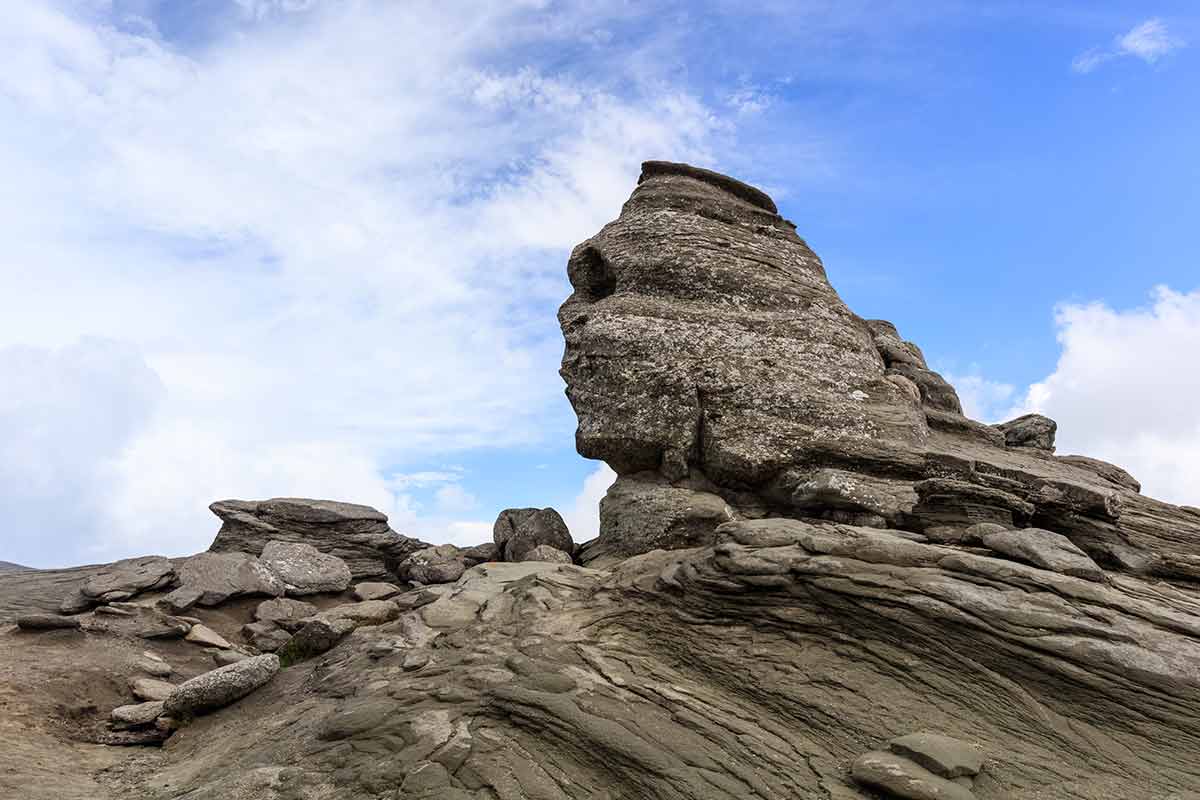
The Sphinx is a natural Romanian monument on the Bucegi Plateau.
This rock formation was eroded over time by wind and rain and eventually resembled a human face.
The Sphinx is at an altitude of 2216m (7270ft), and it is 8m (26ft) tall and 12m (39ft) wide.
There are, however, many alternative theories around how this natural formation was created.
One theory is the Sphinx is an artefact from a civilisation more advanced than our own.
Regardless of the actual theory, this natural rock formation is a photo-worthy natural landmark that is well worth the hike.
The Sphinx is at Moroeni, Dambovita County.
2- Bigar Waterfall
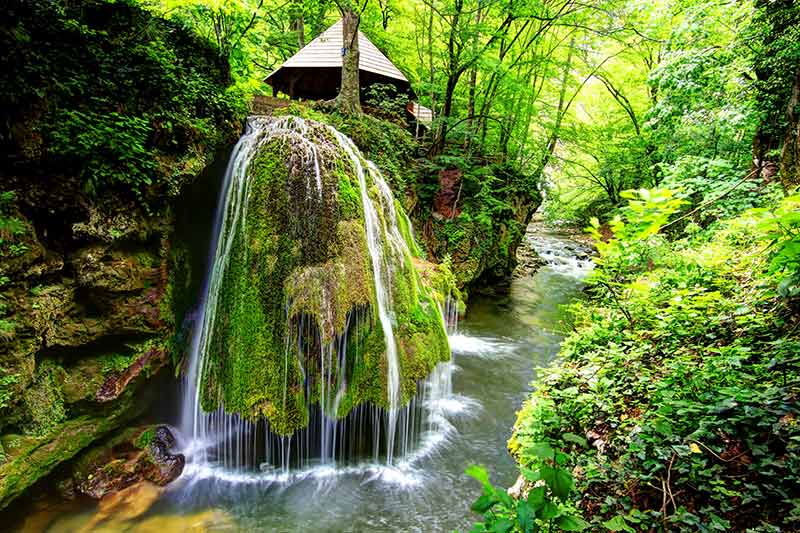
Bigar Waterfall is a magical natural landmark of Romania that is not to be missed.
The waterfall is nicknamed ‘the miracle from the Minis Canyon’ and part of the Mini River, within the Anina Mountains.
The waterfall is unusual in its appearance, as it is rounded and falls over moss-covered rocks resulting in multiple streams of water flowing over the rock.
Even though part of the waterfall has collapsed due to erosion, Bigar is still a magical landmark to visit in Romania.
Bigar Waterfall is at Caras-Severin.
3- Danube Delta
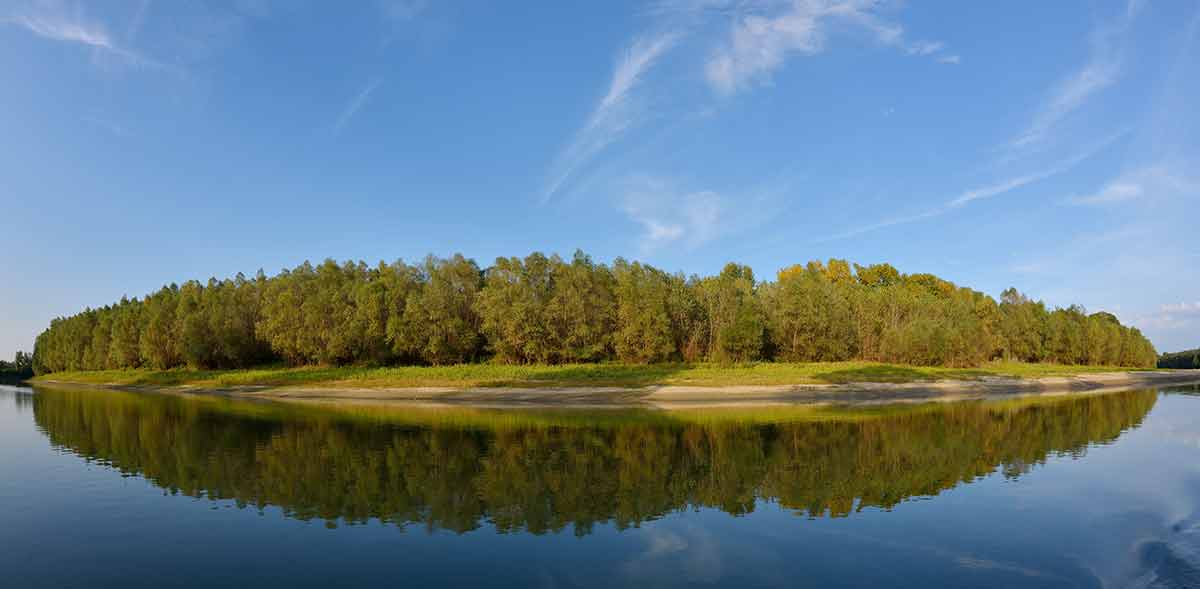
The Danube Delta is part of the River Danube and a serene UNESCO World Heritage site.
The river splits into three separate channels, creating 4187 sq km (1616 sqm) of marsh and wetland.
Within this area are reed islets that offer homes to more than 300 birds. Its waters are filled with 160 species of fish.
Thanks to its rich wildlife, the area is very popular with bird lovers and anyone interested in nature.
The Delta also has secluded beaches allowing for relaxing breaks from exploring the area.
Head to the beach at Sfantu Gheorghe and visit its restaurant, which serves fish caught in the Delta.
Danube Delta is at Tulcea County.
4- Berca Mud Volcanoes
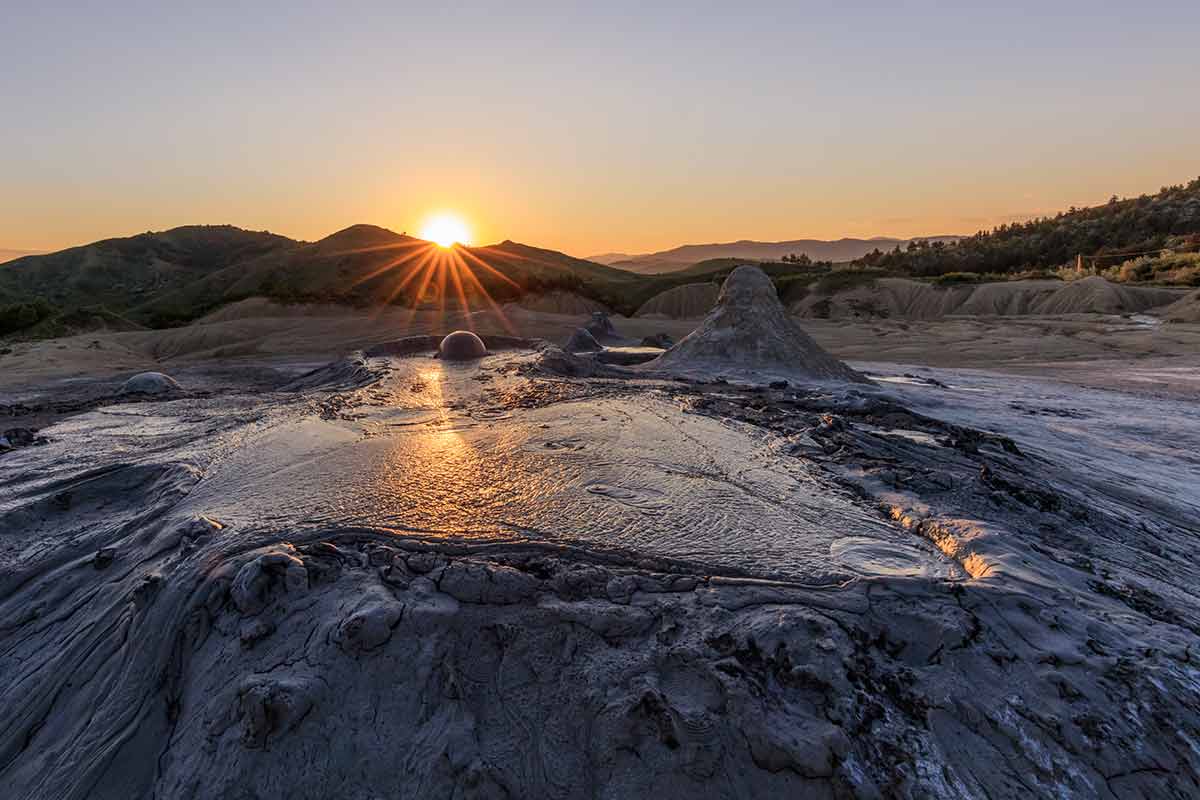
Berca Mud Volcanoes are an incredible and rare geological landmark in Eastern Romania.
As natural gasses rise to the surface, thick mud and salty water begin to bubble.
The constant bubbling of the mud has resulted in conical volcanic shapes as the mud dries on the surface.
Due to the minerals in both the mud and saltwater, the mud volcanoes range from earth tones to dark yellows.
Despite the mud being thick and rich in salt, some plants thrive here.
As only 2% of the world’s plants can tolerate salty conditions, the area has become a nature preserve to protect the plants.
Berca Mud Volcanoes is at Pâclele 127041.
5- Scarisoara Cave
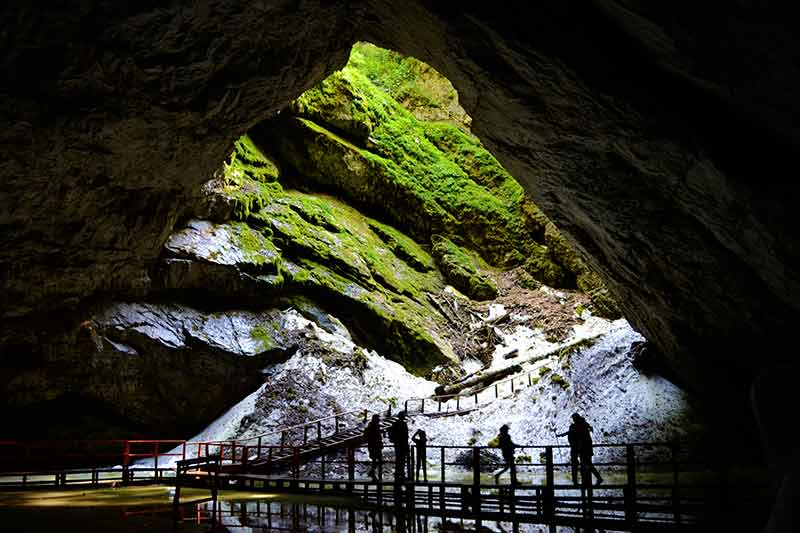
Scarisoara Cave is a natural wonder of Romania as it houses the most extensive underground glacier in the country.
Nature created the glacier due to ventilation within the cave, allowing for the perfect climate for glaciers to form.
It has served as a tourist destination since 1847 and was extensively charted in 1863.
Adolf Schmidlm, an explorer with excellent knowledge of the Apuseni Mountains, made two detailed cave sketches.
The cave is a natural monument that is protected by the government, allowing scientists to carry out experiments in a controlled environment that will not harm the geological phenomena.
It has also allowed Romania to preserve this incredible natural landmark.
Scarisoara Cave is at DN75 54, Gârda de Sus 517321.
For more amazing European Landmarks, read:
- 30 Spain Landmarks
- 20 Switzerland Landmarks
- 22 Germany Landmarks
- 35 London Landmarks
- 30 France Landmarks
- 20 Italy Landmarks
- 20 Greece Landmarks
- 20 Russia Landmarks
- 20 Scotland Landmarks
- 20 Ireland Landmarks
- 21 Wales Landmarks
- 20 Turkey Landmarks
- 20 England Landmarks
- 20 Hungary Landmarks
- 21 Romania Landmarks
- 20 Ukraine Landmarks
- 20 Athens Landmarks
- 20 Rome Landmarks
- 20 England Landmarks
- 20 Portugal Landmarks
- 20 Poland Landmarks
- 20 Iceland Landmarks
- 20 Bulgaria Landmarks
- 21 Croatia Landmarks
- 20 Bulgaria Landmarks
- 20 Austria Landmarks
- 21 Finland Landmarks
- 20 Sweden Landmarks
- 20 Denmark Landmarks
- 20 Belgium Landmarks
- 20 Netherlands Landmarks
- 20 Barcelona Landmarks
- 21 Czech Republic Landmarks
- 20 Landmarks in Paris
- 20 Landmarks in Liverpool
- 10 Istanbul Landmarks
6- Retezat Mountains
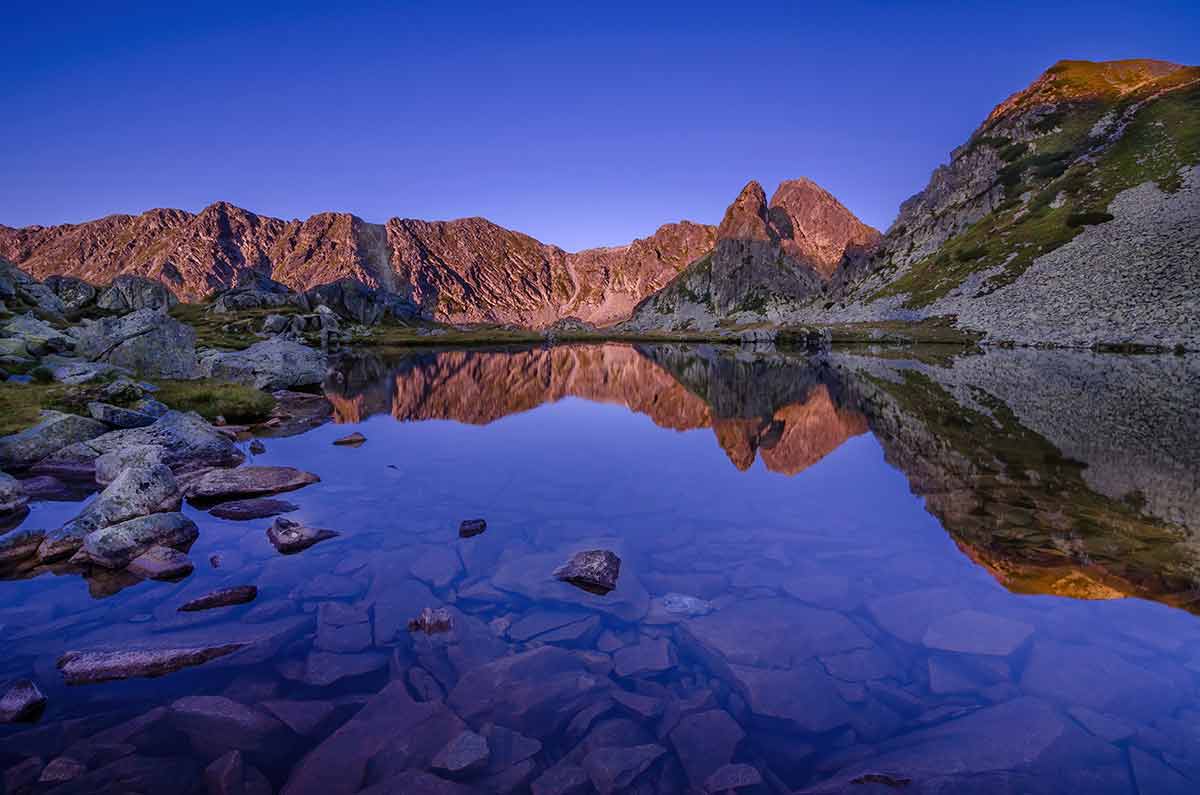
The Retezat Mountains is part of the Southern Carpathians that run through Romania.
The highest peak in the range is Peleaga at 2509m (8232ft).
The range is a must-visit for keen hikers, as it has numerous glacial lakes and pools and densely forested areas.
One of the famous lakes in the range is Bucura Lake which is 2030m (6660ft) above sea level.
More than a third of all native plant species in Romania thrive within the range, including alpine species such as edelweiss and Swiss pine.
Retezat Mountains is at Nucșoara 337423.
7- Babele Mountain Peak
Babble translates to ‘the old woman’, which is an appropriate name for this Romanian natural landmark.
The peak is dotted with unusual rock formations, including the famous Sphinx.
Many of the rocks are shaped to resemble recognisable icons like mushrooms, or old women hunching over.
The rocks were created through wind and rain erosion, resulting in unique formations.
As they were eroded, many layers of rock became visible.
The peak has a chalet which is reachable by cable car and offers accommodation and food for visitors.
There are also many hikes to reach the peak, each taking in the spectacular scenery.
Babele Mountain Peak is at Busteni.
8- Ceahlau Mountain
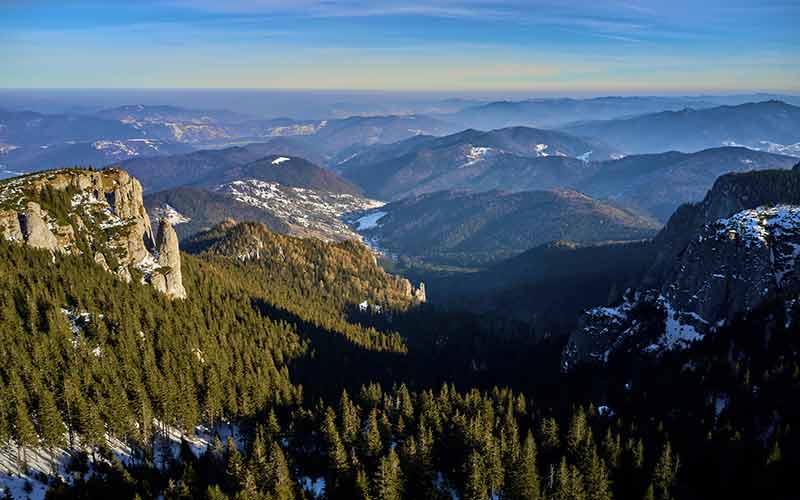
Ceahlau Mountain is popularly known as Romania’s Olympus.
This spectacular mountain is the oldest mountain within the Carpathian range.
The mountain is separated from the others in the range due to valleys thick with pine trees.
At its highest, Ceahlau reaches 1907m (6256ft).
The mountain is popular with hikers and features many scenic trails.
For those wishing to see the mountain at night or early in the morning, two chalets offer accommodation.
Many legends are surrounding the mountain, which dates back to the ancient Dacian gods.
On guided tours of the mountain, expect to hear a legend about certain rock formations or waterfalls.
Ceahlau Mountain is at Neamt County.
9- Letea Forest
Letea Forest has been a protected natural area since the 1930s and is part of the Danube Delta Biosphere Reserve.
Of its 5000 hectares of land, 3000 ha of Letea Forest is protected to allow the numerous plant and animal species here to thrive.
Within the forest are English oak, ash and silver lime trees, many creeper plants that climb the trees and abundant wildlife.
Letea forest is home to white-tailed eagles and badgers, but the most famous animal is the wild horses.
Exploring the forest must be done with an agent from the Danube Delta Biosphere Reserve Administration to keep the forest and its wildlife as protected as possible.
Letea Forest is at Letea.
10- Lacul Sfanta Ana
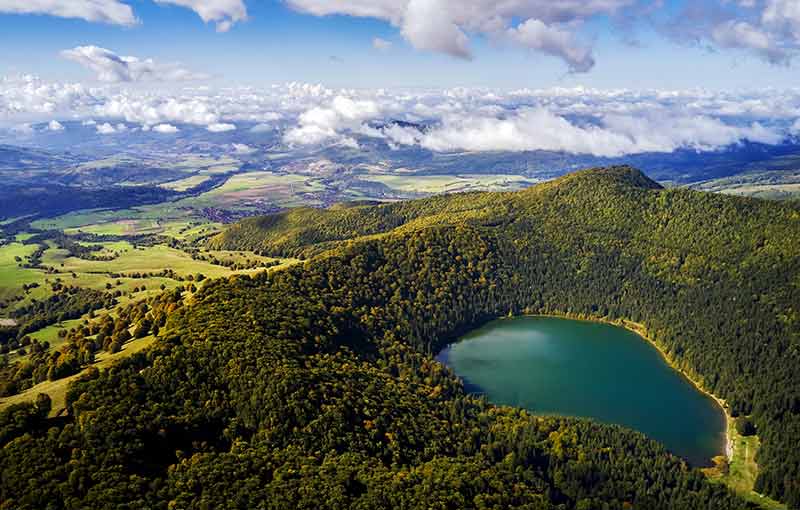
Lacul Sfanta Ana fills the crater of the Puciosul volcano and is the only crater lake in Romania.
The lake is within the Eastern Carpathians and was formed around 9000 years ago.
Lacul Sfanta Ana covers more than 220,000 square meters (2,368,060 square feet) and is 6.4m (21 ft) at its deepest.
The lake is primarily filled with rainwater, which is extremely pure due to the minerals of the volcano.
As it is so pure and has a high oxygen content, no animals live in the lake.
Lacul Sfanta Ana is at Bixad.
Historical Romanian Landmarks
11- Constanta Casino
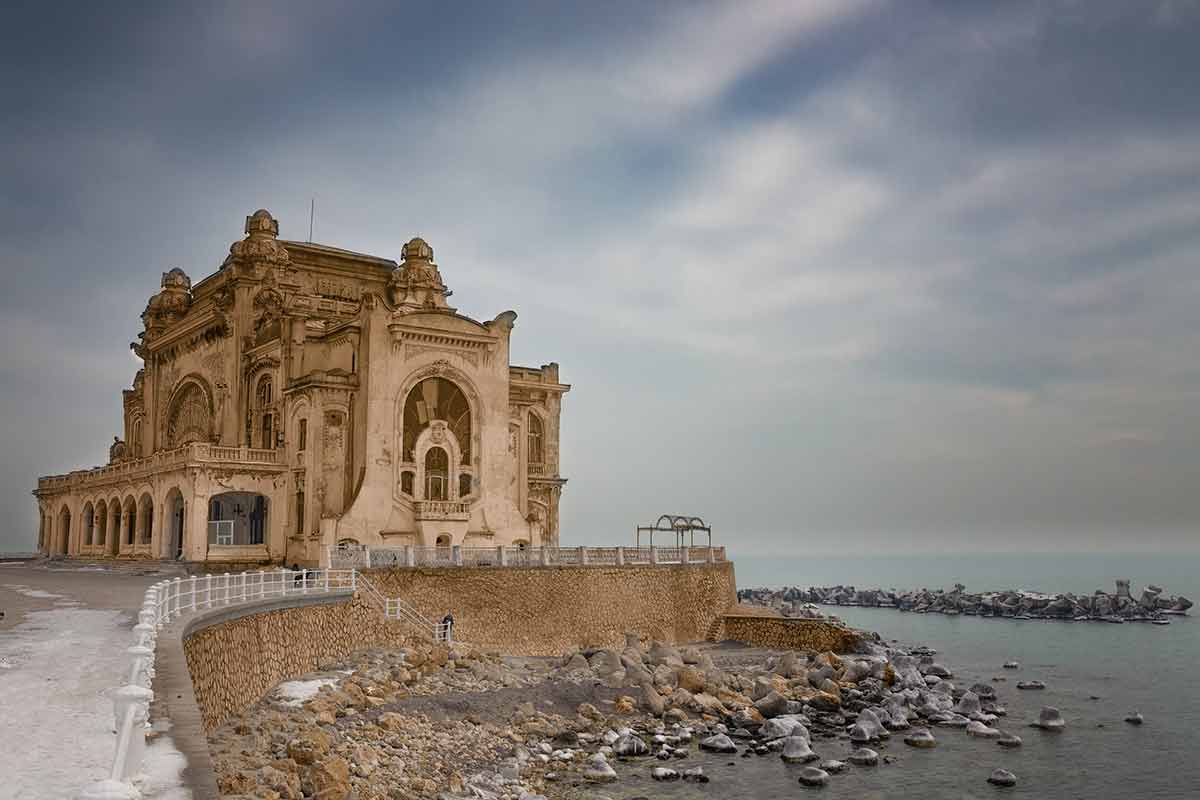
Constanta Casino is an incredible example of Art Nouveau architecture, overlooking the Black Sea.
King Carol I commissioned the casino in the early 1900s, and the king first opened it to the public in 1910.
Thanks to its striking architecture, the casino soon became a must-visit destination in Romania during the 1910s.
Sadly as Romania’s situation worsened over the coming decades, the casino fell into disrepair.
During WWII, the casino was briefly used as a hospital before becoming a restaurant for the communist regime.
Due to the expenses of upkeep on such a grand building, it was closed and abandoned in 1990.
No genuine efforts at restoring the casino have been made.
Constanta Casino is at 19 Bulevardul Regina Elisabeta, Constanta.
12- Bran Castle
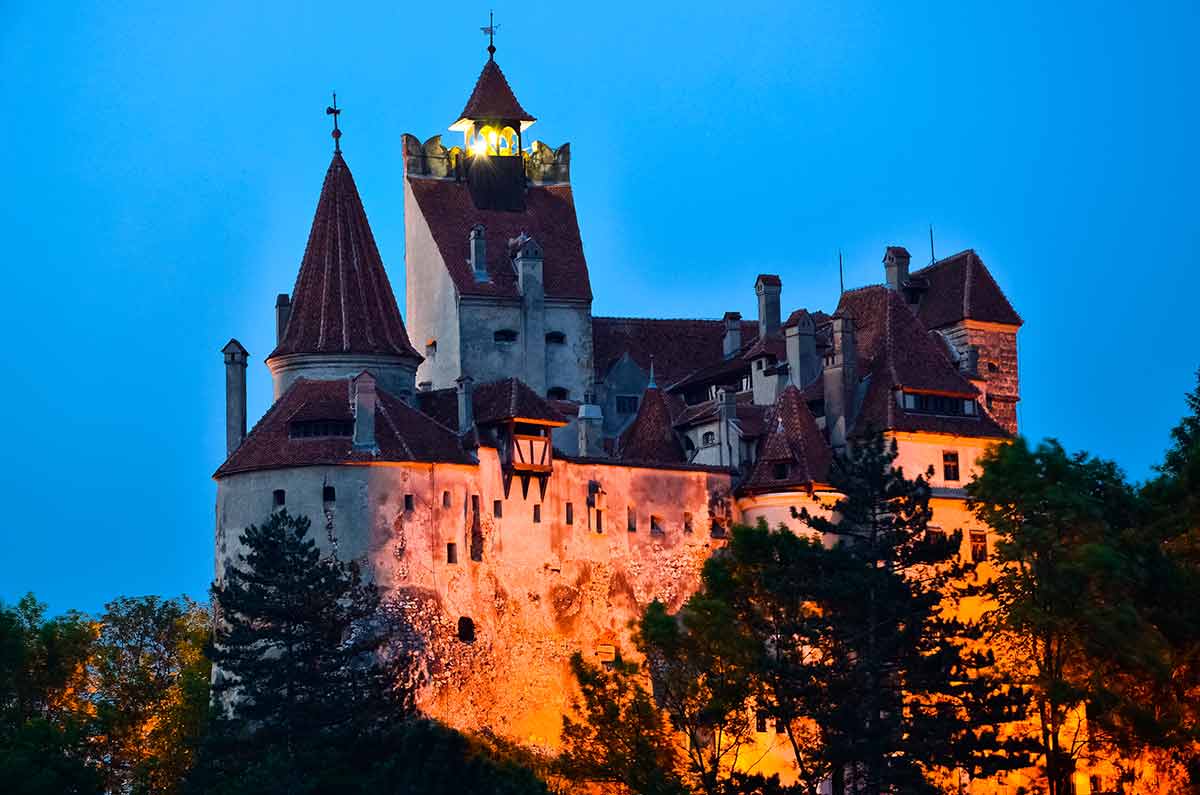
Bran Castle is perhaps the most famous and most visited historic landmark in Romania.
The castle was built in the late 1300s and overlooked the Transylvania and Wallachian mountain pass.
Bran Castle is the inspiration behind Bram Stoker’s Dracula castle even though the author never visited Romania.
However, it is easy to believe this tale as the castle features many underground passages and ancient weapons, the perfect location to create a monstrous villain.
Each year Halloween events are held at the castle to celebrate the famed vampire.
Bran Castle is at Strada General Traian Mosoiu 24, Bran.
13- The Merry Cemetery
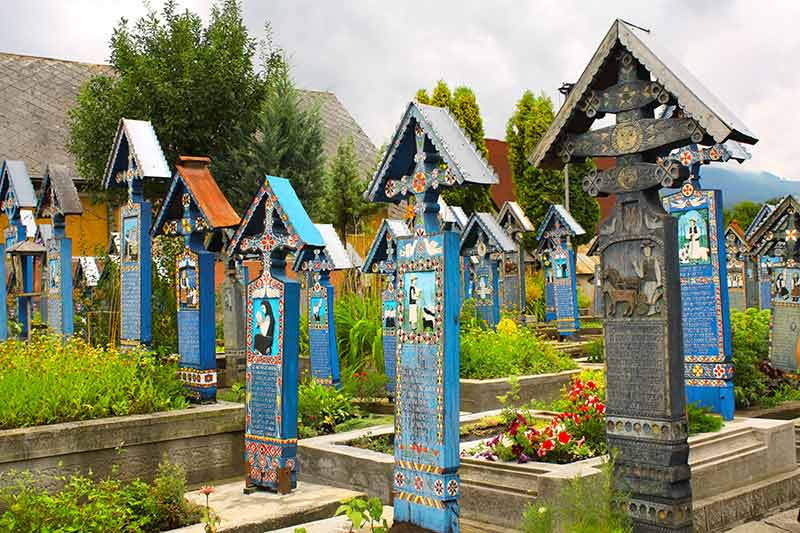
The Merry Cemetery is an unusual and darkly humorous landmark in Romania.
In the town of Sapanta are 800 colourful crosses marking the final resting place of some of its residents.
The crosses feature life stories, hidden secrets, or even the deceased’s final moments before death.
This graveyard is a unique monument to the dead in Romania by displaying these stories in vibrant colours and mosaics and adorning them with poems and limericks.
The crosses began in 1908 when Stan Iona Patras carved crosses for the cemetery and carved poems and images of how the deceased died onto them.
His bold use of colour had meaning behind it, with green representing life and black representing death.
He always finished the crosses in a vibrant blue which represents hope and sky.
Some of the more notable graves depict a car hitting a person and the gruesome beheading of soldiers.
The Merry Cemetery is at Church of the Assumption, Maramures County, Sapanta, 437305.
14- The Palace of the Parliament
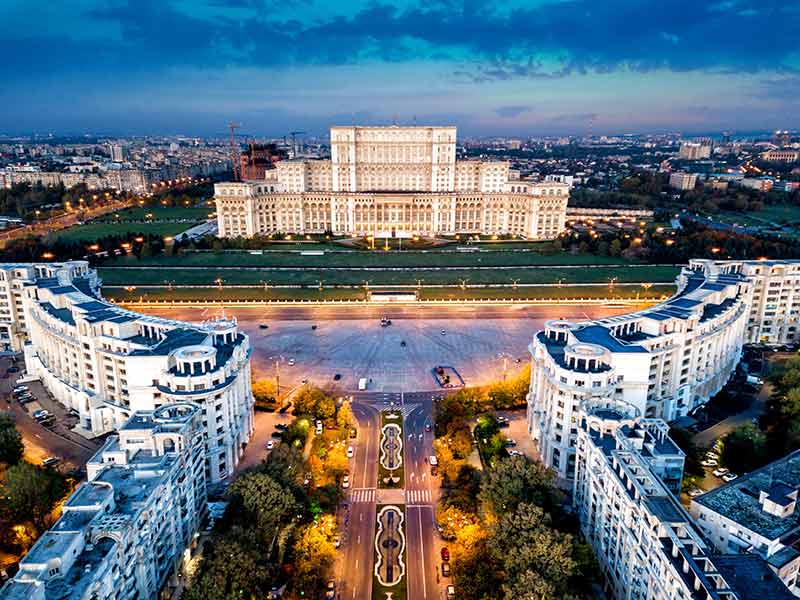
The Palace of the Parliament was once named the People’s Palace and is a lasting reminder of communist rule over Romania.
The communist design of the building reflects prosperity in a multilateral society.
The building is the second-largest administrative building globally, and despite construction beginning in 1984, the palace is incomplete.
During the buildings two-billion-dollar construction, the residents of Romania were starving, with food shortages rife, and cuts to gas and electricity a frequent occurrence.
The creation of the palace also displaced 40,000 people who had to vacate their homes so the palace could be built.
It is possible to tour the palace on a guided tour, which takes you into the palace’s main rooms, with complete tours taking in the basement.
The Palace of the Parliament is at 2-4 Strada, Izvor, Bucharest.
15- Peles Castle
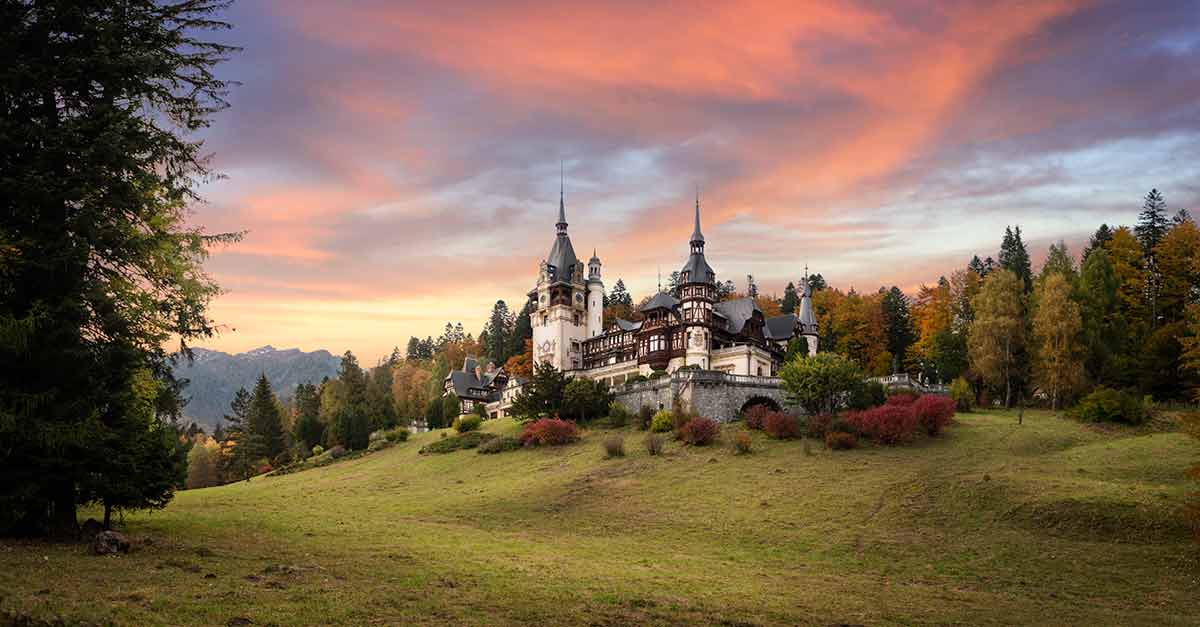
King Carol I commissioned Peles castle in 1873 as the summer residence for the royal family.
The castle’s 160 rooms are decorated with incredible European art and sculpture.
Within these rooms are examples of Murano glass chandeliers and exquisite stained glass windows.
The king wanted the castle to be at the forefront of luxury architecture.
To ensure this he built a power plant to allow the court to have electricity and a central heating system offered running hot and cold water.
Each of the rooms within the castle follows a different theme based on a country, including the lavishly decorated Indian music room.
Peles Castle is at Alexa Pelesului 2, Sinai’s 106100.
Discover more Famous World Landmarks:
- 25 Australian Landmarks
- 20 New Zealand Landmarks
- 20 African Landmarks
- 21 Egyptian Landmarks
- 20 Jordan Landmarks
- 10 Tasmanian Landmarks
- 20 Antarctica Landmarks
16- Sighisoara Clock Tower
Sight soar a Clock Tower is a beautiful example of Romanian architecture.
The tower was built during the 14th century and features a spectacular multicoloured tiled roof.
Climb the tower to take in the breathtaking views of the town and the surrounding landscapes.
The tower features a museum within its walls focusing on Roman artefacts taken from the surrounding area during excavations.
The collection includes tombstones and vessels.
Sighisoara Clock Tower is at Piata Muzeului 1, Sighisoara.
17- Transfăgărășan
Transfagarasan was named the best driving road in the world by Top Gear during their trip to Romania.
Authorities built the road during the 1970s using more than 6000 tonnes of dynamite, which sadly resulted in more than 40 lost lives.
The road winds its way through the Carpathian Mountains and features tight corners and fast straights surrounded by towering mountains, making it an incredible place for a drive.
The road scales up through the mountains offering breathtaking views over the valley.
Transfagarasan is part of National Road 7C and begins near Bascov.
18- Voronet Monastery
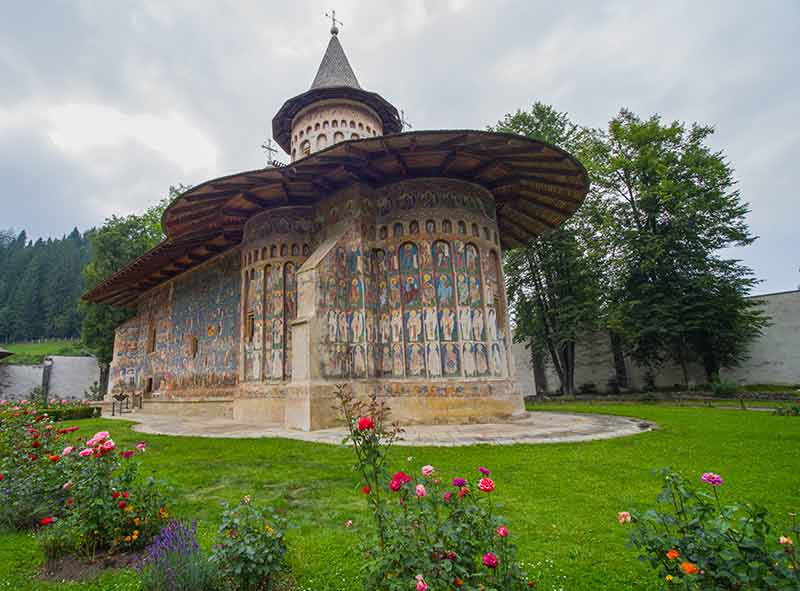
Stephen the Great founded Voronet Monastery in 1487 to celebrate a victory over the Turks.
The monastery is also known as the ‘Sistine Chapel of the East’, as elaborate paintings that adorn both interior and exterior walls.
The paintings primarily feature scenes from the Bible and include the Ladder of St John and the Last Judgement.
Further imagery conveys angels, demons and apostles.
The monastery thrived at Voronet until 1785, when it was abandoned during Habsburg rule.
A community of nuns returned to the monastery in 1991 and now run guided tours of the monastery, taking in its paintings.
The nuns also run painting workshops.
Voronet Monestary is at Strada Voronet 166, Voronet 725301.
19- Sarmizegetusa Regia
Once the capital of the Dacian Kingdom, Sarmizegetusa Regia is an ancient kingdom, now a ruin, wrapped in mystery heightened by its mountainous location.
The ruins are reachable only following a challenging climb, however, the reward is worth the hike.
Sarmizegetusa Regia is within the Orastie mountains and rests on a 1200m (3937ft) high plateau.
The Dacian people lived here for around 150 years and carried out military and political activities here.
Much of the ruins are of citadels and fortifications, which were built to protect the city.
Sarmizegetusa Regia is at DJ705A 66a, Costesti 337327.
20- Histria
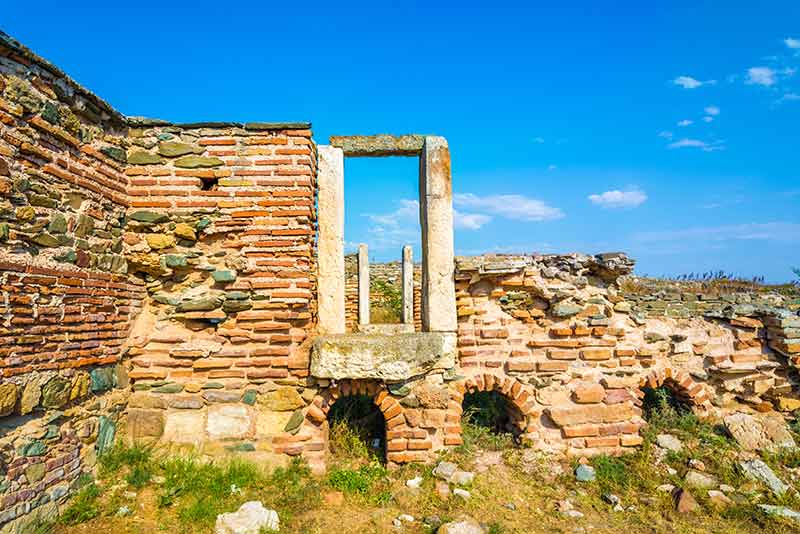
Histria is the country’s oldest town and a must-visit historical landmark of Romania.
The town was settled in 657BC by the Greeks who traded in the area.
Following numerous invasions and a port that gradually became landlocked due to natural movements in the sands, Histria was abandoned in the 7th century.
During the late 19th century, explorers discovered the ruins of the town and extensive excavations took place.
Many of the artefacts found within the town are housed in a dedicated museum, whilst the ruins are open to the public.
Visit the sacred zone, where the remains of a 6th-century Greek temple were found.
Histria is at Istria, Constanta.
21- Central University Library
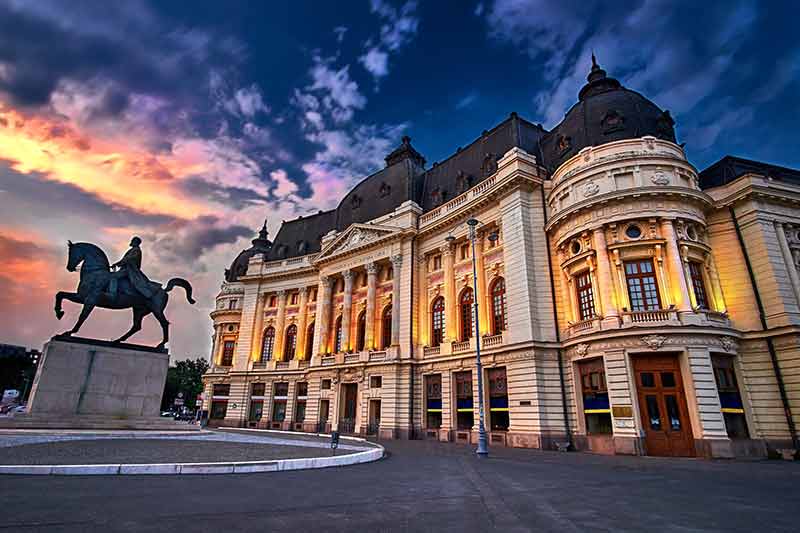
Opposite the National Museum of Art is the architecturally lovely Central University Library of Bucharest.
It’s the oldest university library in Romania’s capital and is a repository for cultural and educational traditions.
The library was a project of King Carol I and during its heyday, it was considered a landmark for Romania’s culture.
At the front of the building, there’s an impressive equestrian statue of King Carol I.
Central University Library is at Strada Boteanu 1, Bucharest.
Exploring Eastern Europe? You may also like:
- 20 Landmarks in Bulgaria
- 20 Bulgarian Cities
- 20 Things To Do In Sofia
- 22 Landmarks in Hungary
- 20 Cities in Hungary
- 15 Things Hungary Is Famous For
- 22 Castles in Czech Republic
- 21 Landmarks in Czech Republic
- 20 Things To Do In Prague At Night
- 15 Things To Do In Prague
- 20 Day Trips From Belgrade
- 10 Things To Do In Belgrade
- 20 Cities in Serbia
- 20 Things To Do In Baku
- 20 Slovakian Cities and Towns
- 20 Slovenian Cities and Towns
- 20 Latvian Cities and Towns
- 20 Castles in Poland
- 20 Landmarks in Poland
- 20 Polish Drinks
- 20 Cities in Poland
- 20 Things To Do In Warsaw
- 20 Things To Do In Krakow
- 20 Things To Do In Krakow At Night
- 20 Things To Do In Gdansk
- 20 Castles in Romania
- 20 Landmarks in Romania
- 20 Cities in Romania
- 20 Castles in Belarus
- 20 Things To Do In Tbilisi
- 20 Things To Do In Armenia
- 20 Cities In Armenia
- 20 Things To Do In Riga
- 20 Things Romania Is Famous For
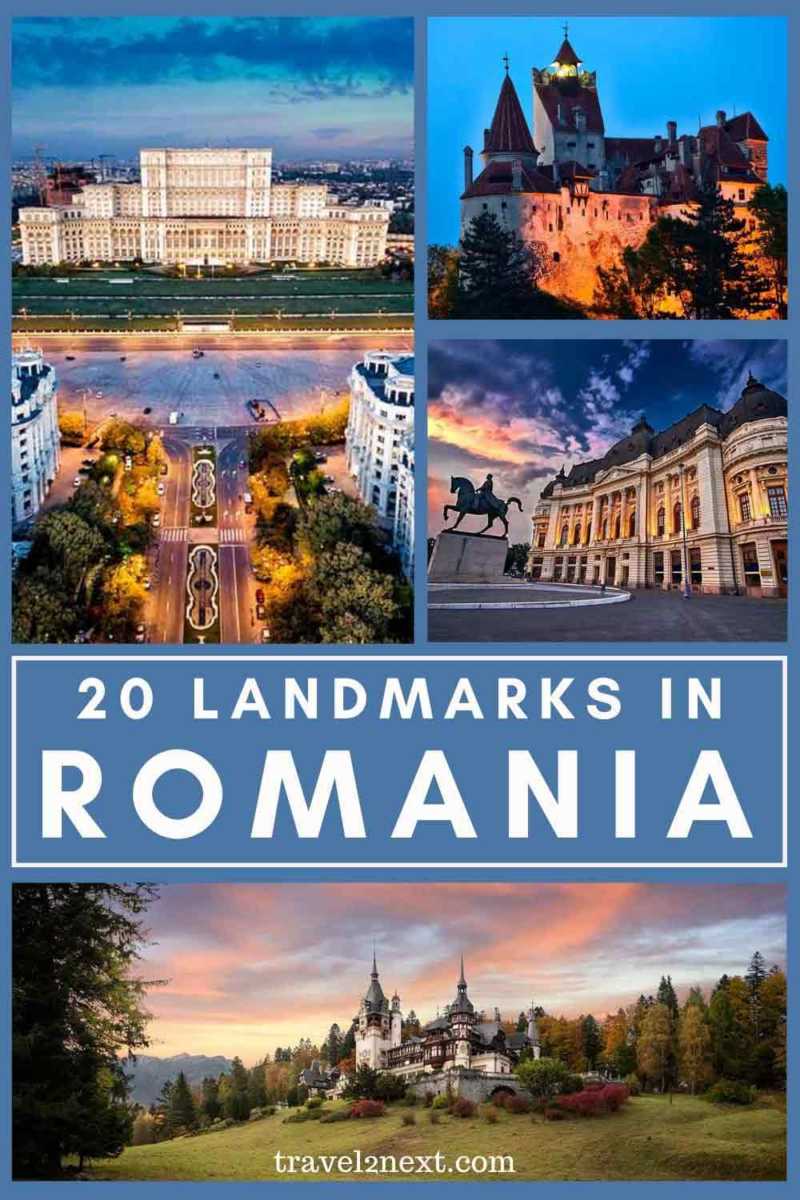
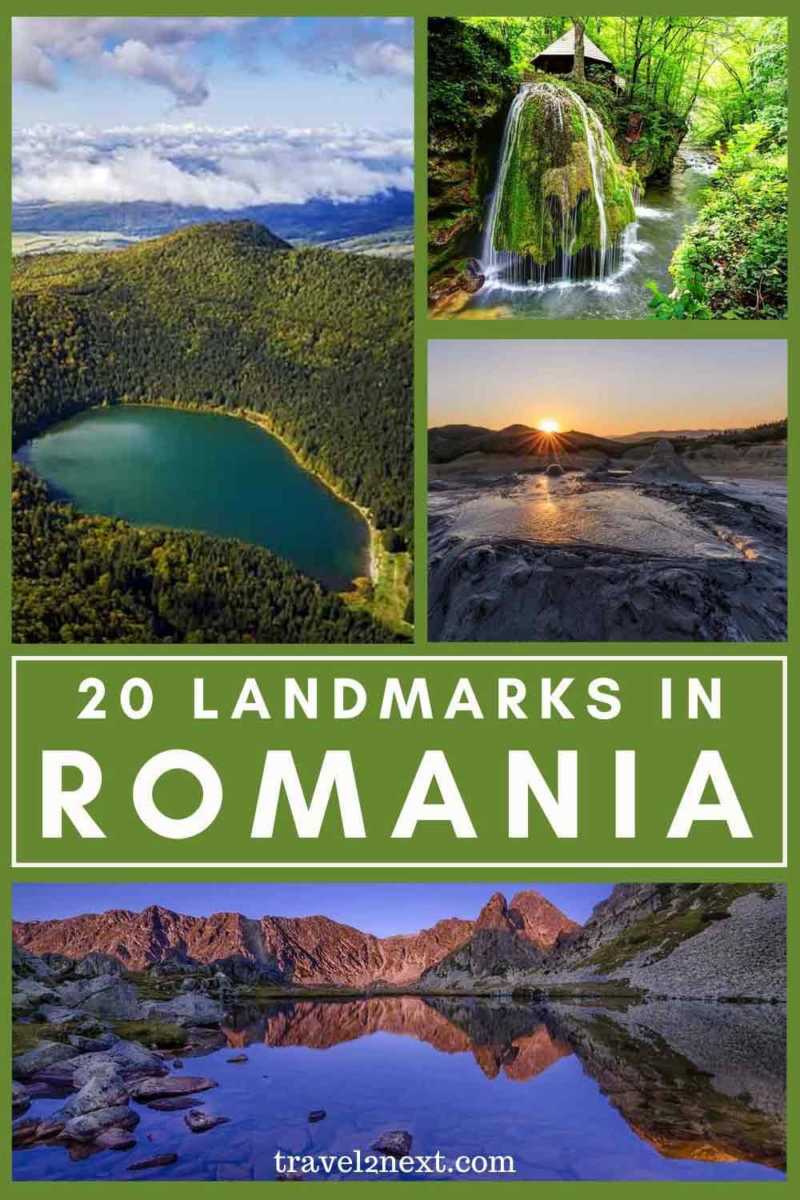
Plan Your Trip

Rent A Car – Find the best car rental rates at Discover Cars. They compare car hire companies to provide you with the best deal right now.

Find A Hotel – If you’re curious about this article and are looking for somewhere to stay, take a look at these amazing hotels.

